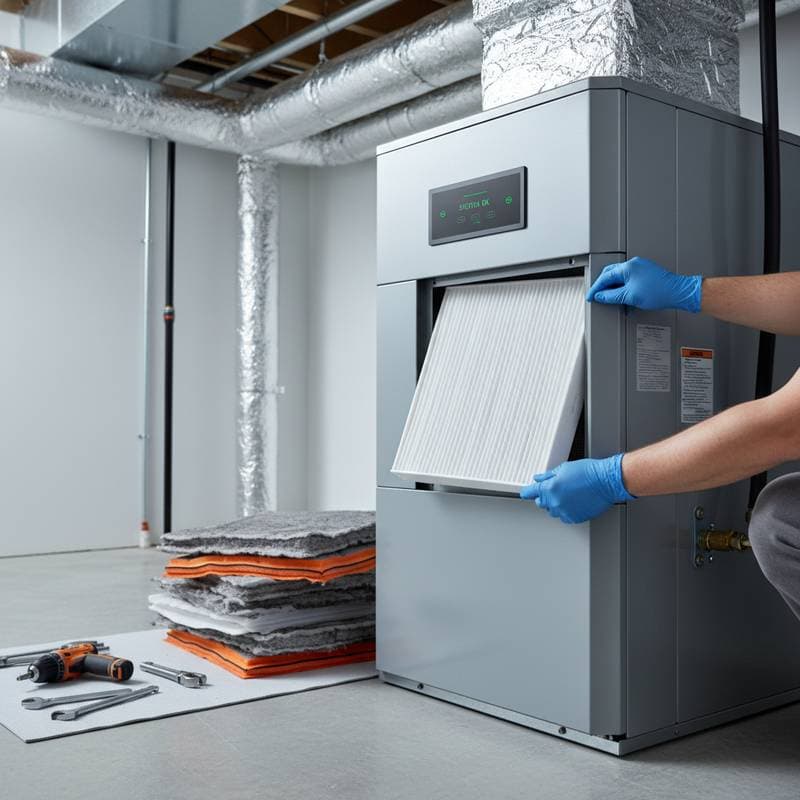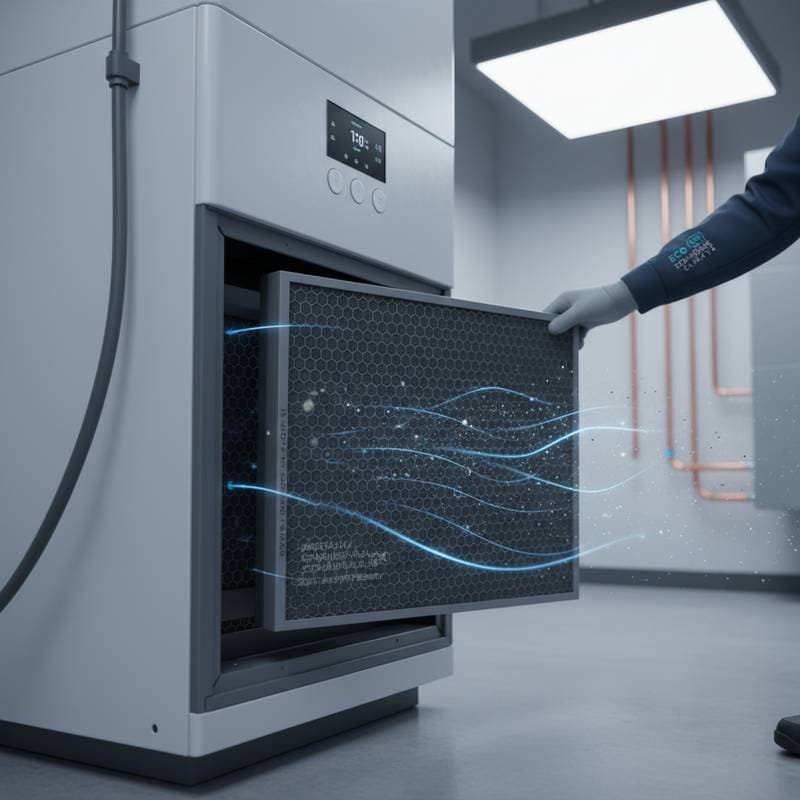Why Insurance Companies Require Indoor Air Quality Monitors
Insurance companies increasingly mandate indoor air quality (IAQ) monitors as a standard condition in homeowners' policies. These devices measure pollutants, humidity, and airborne particles to deliver real-time insights into the air within living spaces. Insurers view them as essential tools for mitigating risks that lead to claims, much like smoke detectors or security systems.
The installation cost for an IAQ monitor typically falls between $150 and $500, varying by model features such as sensor precision and smart connectivity. In homes equipped with advanced heating, ventilation, and air conditioning (HVAC) systems, these monitors integrate seamlessly to optimize air circulation and issue timely notifications. This guide explores the reasons behind these mandates, the mechanics of IAQ sensors, their advantages, and strategies for homeowners to meet requirements affordably.
Reasons Insurance Companies Mandate IAQ Monitors
Insurers prioritize preventive measures to curb financial losses from health issues and property damage. Requiring IAQ monitoring aligns with this strategy by fostering healthier environments and reducing claim frequency.
Mitigating Health Claims
Indoor pollutants, mold spores, and allergens often trigger respiratory conditions and long-term health problems. When poor air quality contributes to illnesses, insurers encounter elevated medical reimbursement requests. IAQ monitors enable early detection, empowering homeowners to address concerns promptly and avert severe outcomes.
Averting Mold and Moisture Issues
Excessive humidity fosters mold proliferation, resulting in extensive structural repairs. Monitors equipped with humidity sensors provide alerts for elevated moisture, allowing interventions like dehumidifier activation or ventilation adjustments. This capability spares insurers from funding substantial remediation efforts.
Leveraging Smart Home Analytics
Modern insurance assessments incorporate data from connected devices to evaluate property risks accurately. IAQ monitors supply ongoing metrics comparable to those from leak sensors or fire alarms, informing insurers about maintenance practices. Such integration supports refined risk models and incentivizes proactive upkeep.
Promoting Hazard-Free Environments
Providers seek to eliminate dangers proactively rather than react to incidents. Continuous IAQ surveillance equips residents to respond before conditions deteriorate, aligning with insurers' objectives to safeguard lives and assets effectively.
Factors Influencing IAQ Monitor Expenses
The overall expense of acquiring and sustaining IAQ monitors depends on several variables, from device specifications to installation scope.
Sensor Capabilities
Basic units focus on temperature and humidity, keeping costs low. Advanced models incorporate sensors for volatile organic compounds (VOCs), particulate matter, and specific gases, necessitating periodic calibration that increases long-term investment.
Integration and Connectivity Options
Wi-Fi-enabled monitors that link to home networks or HVAC controls command higher prices due to their automation features, such as remote monitoring and system adjustments. Compatibility with ecosystems like Nest or Ecobee enhances functionality and aids in fulfilling policy stipulations.
Property Dimensions and Configuration
Comprehensive coverage in expansive residences demands multiple monitors, one per level or functional area, to capture zone-specific data reliably. Insurers may stipulate this arrangement for policy validation.
Ongoing Upkeep and Adjustments
Annual or biennial sensor recalibration or replacement incurs fees of $50 to $150 per unit. Precise functionality remains vital for maintaining insurance standing, so homeowners benefit from scheduling routine professional inspections.
Incentives and Cost Reductions
Certain providers grant premium reductions or rebates for approved IAQ installations, particularly through energy-efficiency initiatives. Review policy terms or contact your agent to identify applicable savings opportunities.
Achieving Compliance with Insurance Policies on IAQ Monitoring
IAQ requirements parallel mandates for other safety features, such as carbon monoxide detectors. Non-adherence may jeopardize coverage or complicate claim processes.
Key Compliance Criteria
Insurers typically expect monitors to:
- Operate continuously with reliable connectivity
- Hold certifications from accredited bodies like UL or EPA
- Generate accessible data records upon request
- Activate notifications for elevated pollutants or malfunctions
Proving Installation and Performance
Submit installation certificates or periodic reports to verify adherence. Automated systems that transmit data directly to insurer portals streamline this verification, reducing administrative burdens for homeowners.
Frequently Asked Questions About IAQ Monitors
Do These Monitors Influence Insurance Rates?
Equipping a home with IAQ monitors frequently qualifies it for reduced premiums, as the technology diminishes damage and health claim probabilities. Although discounts vary by provider, the preventive benefits often yield substantial savings over time.
How Frequently Do Monitors Require Calibration?
Contemporary devices run autonomously, yet accuracy demands regular checks. Adhere to manufacturer guidelines for testing, typically every six to twelve months, and replace components as indicated by self-diagnostic features.
Can Monitors Identify Carbon Monoxide or Radon?
Premium models include dedicated sensors for these hazards. For units lacking such capabilities, supplement with standalone detectors to satisfy both safety and insurance standards; confirm specifications prior to selection.
What Are the Consequences of Overlooking Alerts?
Disregarding notifications risks mold development, ventilation failures, or toxic exposures. Insurers might reject associated claims if evidence shows neglect, underscoring the importance of swift action for protection and eligibility.
Is IAQ Monitoring Mandatory for Every Residence?
Requirements emerge selectively, often targeting newer constructions or high-risk properties. Voluntary adoption nonetheless bolsters policy terms and personal well-being, positioning homeowners advantageously as standards evolve.
Obtaining Quotes for IAQ Monitor Installation
Thorough comparison ensures optimal selection tailored to your needs. Engage licensed HVAC specialists for detailed proposals that cover installation, integration, and support.
Essential Inquiries for Contractors
- Which monitor models suit my home's scale and layout?
- Will they connect seamlessly to my existing HVAC setup?
- What is the recommended schedule for sensor maintenance?
- Do you offer bundled services for calibration and repairs?
- How do your installations align with insurer expectations?
- What warranties apply to the equipment and labor?
- Can you prepare documentation for my insurance submission?
- Are radon or carbon monoxide detection options available?
- How is monitoring data managed and protected?
- What comprises the full pricing for setup and upkeep?
Sustaining IAQ Systems for Enduring Advantages
Post-installation, routine care preserves efficacy: swap filters as scheduled, track humidity trends, and confirm sensor precision through tests. Document all activities to demonstrate compliance during audits.
Beyond meeting mandates, IAQ monitors elevate daily living by purifying air, averting health threats, and upholding property integrity. As preventive technologies gain prominence in insurance frameworks, early investment secures cleaner environments, minimized vulnerabilities, and favorable policy interactions.





